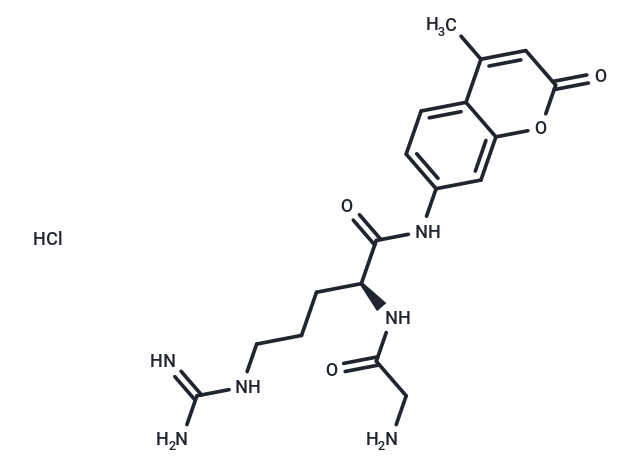Shopping Cart
- Remove All
 Your shopping cart is currently empty
Your shopping cart is currently empty

Gly-Arg-AMC is a fluorogenic substrate for cathepsin C.1 Upon enzymatic cleavage by cathepsin C, 7-amino-4-methylcoumarin (AMC) is released and its fluorescence can be used to quantify cathepsin C activity. AMC displays excitation/emission maxima of 340-360/440-460 nm, respectively.

| Pack Size | Price | Availability | Quantity |
|---|---|---|---|
| 1 mg | Inquiry | 35 days | |
| 5 mg | Inquiry | 35 days | |
| 10 mg | Inquiry | 35 days | |
| 25 mg | Inquiry | 35 days |
| Description | Gly-Arg-AMC is a fluorogenic substrate for cathepsin C.1 Upon enzymatic cleavage by cathepsin C, 7-amino-4-methylcoumarin (AMC) is released and its fluorescence can be used to quantify cathepsin C activity. AMC displays excitation/emission maxima of 340-360/440-460 nm, respectively. |1. Rubach, J.K., Cui, G., Schneck, J.L., et al. The amino-acid substituents of dipeptide substrates of cathepsin C can determine the rate-limiting steps of catalysis. Biochemistry 51(38), 7551-7568 (2012). |
| Molecular Weight | 424.89 |
| Formula | C18H25ClN6O4 |
| Cas No. | 70274-78-1 |
| Storage | Powder: -20°C for 3 years | In solvent: -80°C for 1 year | Shipping with blue ice. | ||||||||||||||||||||||||||||||
| Solubility Information | DMSO:PBS (pH 7.2) (1:1): 0.5 mg/mL (1.18 mM), Sonication is recommended. DMSO: 30 mg/mL (70.61 mM), Sonication is recommended. Ethanol: 20 mg/mL (47.07 mM), Sonication is recommended. DMF: 30 mg/mL (70.61 mM), Sonication is recommended. | ||||||||||||||||||||||||||||||
Solution Preparation Table | |||||||||||||||||||||||||||||||
Ethanol/DMSO/DMF
DMSO/DMF
| |||||||||||||||||||||||||||||||

Copyright © 2015-2025 TargetMol Chemicals Inc. All Rights Reserved.